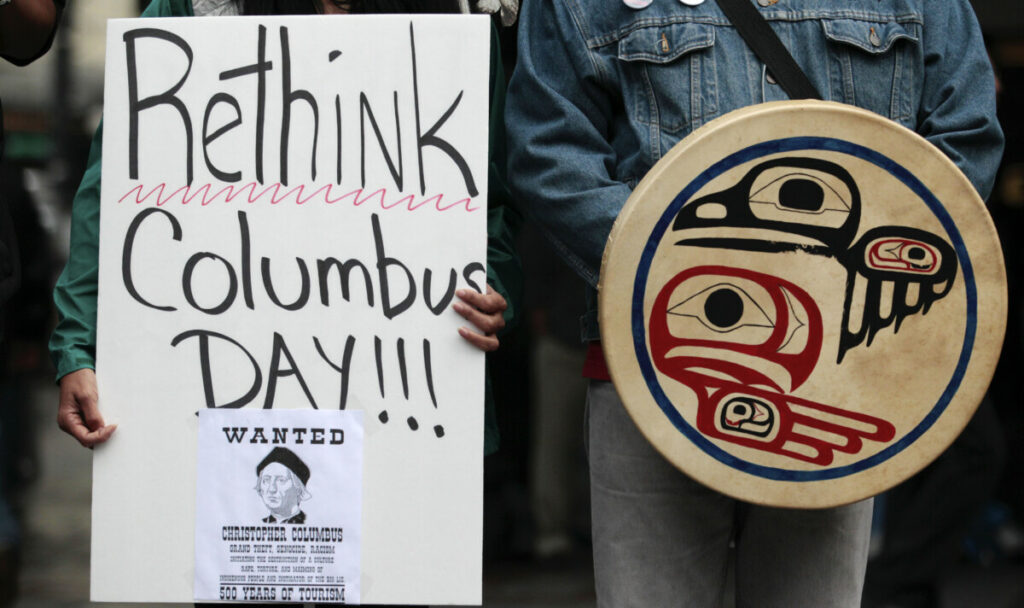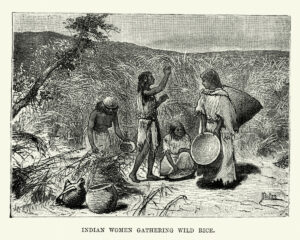Learn about Indigenous Peoples’ Day, where it originated from, and how you can celebrate.
Indigenous Peoples’ Day originated in the late 1980s as a reaction to the controversial history behind Columbus Day. Since many people may think of the established holiday only in terms of a day off work or school, or a bank and post office holiday, some may wonder where the new holiday came from, why the change occurred, and how to best celebrate it.
Indigenous Peoples’ Day Origins
Before Indigenous Peoples’ Day
The first Columbus Day celebration took place on October 12, 1792 when Tammany Hall held an event to celebrate the 300th anniversary of Christopher Columbus’s landing in the Americas. Columbus Day was later introduced as a day to celebrate Italian American culture. The day was a peace offering to combat growing sentiment against Italian Americans. The tipping point came when 11 Italian Americans were lynched in New Orleans. President Harrison declared the one-time holiday, Columbus Day, to celebrate contributions of Italians to the Americas. In 1968, President Johnson signed legislation designating Columbus Day as a federal holiday to be celebrated every second Monday of October.
Columbus Day Controversy

The history of Christopher Columbus
Christopher Columbus, namesake of Columbus Day, was an Italian-born explorer. In 1492, he received funding from King Ferdinand and Queen Isabella of Spain to explore the spice trade in the East Indies. Columbus was promised, contingent on success, he would be promoted to Admiral of the Ocean. He would also hold the title of Viceroy and Governor of all new lands he claimed for Spain.
Columbus took his three ships and set sail for the Indies. He arrived on October 12, 1492, at Guanahani (an island in the Bahamas). His exploration stretched throughout the indies into Cuba and Hispaniola. Columbus reigned for seven years as first governor of the West Indies. Accounts and reports from those close to him described Columbus as a leader. There are also reports of criticism from churchmen of Columbus. Due to his economic interest in the slave trade, he would not baptize the Hispaniola natives so that he could sell them into slavery. Forced assimilation, spread of disease, mistreatment, and abuse decimated the native population of Hispaniola and other colonies.
After accounts of his brutality and mistreatment reached the Spanish crown, he was removed from his post. Later the tension between himself and the Crown of Castile led to his arrest and removal from Hispaniola in 1500. A report was drawn up by Spanish monarchs in response to the growing rumors of Columbus’s abuse. Later analyzed by Spanish historian Consuelo Varela, it became obvious that “Columbus’s government was characterized by a form of tyranny. Even those who loved him had to admit the atrocities that had taken place.”
Consequences to Indigenous People after Columbus
Many horrible ripple effects came from Columbus’s reign in the Americas. The mistreatment and Old World diseases brought by Columbus are held responsible by academics for the population decline of the Indigenous Tainos in Hispaniola. Columbus was dubbed the “father of the slave trade” by British historian Basil Davidson. Davidson cites the first license to ship enslaved Africans to the Caribbean, issued by Catholic Monarchs in 1501 to the first royal governor of Hispaniola, Nicolás de Ovando, who was following the example set by Columbus to the end.
Around the turn of the 21st century, estimates for the pre-Columbian population of Hispaniola ranged between 250,000 and two million, but genetic analysis published in late 2020 suggests that smaller figures are more likely, perhaps as low as 10,000–50,000 for Hispaniola and Puerto Rico combined. One of the authors in the study, our very own Miguel Vilar, had this to say about the genetics of the Caribbean.
“What I find most interesting from these studies in ancient and modern DNA from the Caribbean is that there is <1% indigenous Y-DNA left in the Caribbean, whereas there is more than 60% indigenous mitochondrial DNA in Puerto Rico, and about 40% in Cuba. In Hispaniola there is less, but there is a much higher African Y-DNA and mtDNA there. Hispaniola was the place where the Columbus family governed, and where people were brought to from Africa. It was also the place where thousands of them escaped, rebelled, and formed their own country called Haiti. So, the decimation of native peoples is clear, but it was NOT equal among groups. The Native men died, were killed or “removed” from the population, whereas the native women became the mothers of the future generations of Caribbean islanders. This is very pronounced in Puerto Rico and Cuba, however the patterns are not the same in the English or French-speaking Caribbean.”
He continued, “I don’t know for sure [why there is a difference in the Spanish Caribbean] other than the Spanish conqistadors were mostly men coming over and were very comfortable taking indigenous women as wives, lovers, or possibly raping them. The French and English, in contrast, may have come as families and would hardly mix with the indigenous people, but instead enslaved, disenfranchised, and ultimately replaced them with African-born peoples. The Anglo and Franco Caribbean now is what we think of the “Afro-Caribbean,” places like Jamaica, Trinidad, Martinique, Virgin Islands. Whereas the Hispano Caribbean is more a genetic admixture of European, with varying degrees of Indigenous and African DNA mixed in.”
In the century following the arrival of Columbus, it is estimated that the native population of the Americas as a whole fell by about 90%.
Adoption of Indigenous Peoples’ Day

In 1989, South Dakota became the first state to adopt Indigenous Peoples’ Day. In 1992, a group known as the ‘Resistance 500 Coalition’ protested San Francisco’s celebration of the 500th anniversary of Columbus’s arrival to the Americas. The group, a part of the Bay Area Indian Alliance, promoted the idea that Columbus’s colonization of America resulted in the genocide of thousands of indigenous peoples. Following this protest, Berkeley. California adopted Indigenous Peoples’ Day.
Soon, other states followed the example set by South Dakota and Berkley. In 2015, Alaska was the next state to adopt Indigenous Peoples’ Day. In 2016, Minnesota and Vermont joined in adopting the new holiday. And by 2021, 11 states, the District of Columbia, and the federal government adopted Indigenous Peoples’ Day as a holiday.
The holiday began as a counter-celebration of Columbus Day. Today, Indigenous Peoples’ Day is a celebration of Native history, contributions, and culture.
Indigenous Peoples’ Day Celebrations
According to Mandy Van Heuvelen, a member of the Cheyenne River Sioux Tribe from South Dakota, there are no set rules on how one should appreciate the day. It’s all about reflection, recognition, celebration and education. When interviewed by NPR she stated, “It can be a day of reflection of our history in the United States, the role Native people have played in it, the impacts that history has had on native people and communities, and also a day to gain some understanding of the diversity of Indigenous peoples.” And while there are many ways that those reflections can take place, one of the most popular is to enjoy the art that Indigenous People have created to share their story. Books, movies, and fine art such as paintings and sculptures express the Native narrative for those curious about communities and histories.
Indigenous Art
One way to celebrate Indigenous People is to celebrate their art. Art can be a great medium of expression, especially about complicated concepts like Indigenous life. A few types of art that you could indulge in on Indigenous Peoples’ Day are books and movies.
Books for Adults
Written stories, both fiction and non-fiction, are a great way for indigenous people to be heard. Below is a short list of books, written by indigenous authors.
- Ceremony by Leslie Marmon Silko (Laguna Pueblo Indian)
- Dark. Sweet. by Linda Hogan (Chicksaw)
- Fresh Banana Leaves by Jessica Hernandez (Maya Ch’orti’ and Zapotec)
- The Heartbeat of Wounded Knee by David Treuer (Ojibwe)
- Love Medicine by Louise Edrich (Ojibwe)
- Mankiller: A Chief and Her People by Wilma Mankiller (Cherokee)
- Our History Is the Future by Nick Estes (Sioux)
- When My Brother Was an Aztec by Natalie Diaz (Mojave)
- WHEREAS by Layli Long Soldier (Lakota)
Kids Books
Emphasizing the importance of Indigenous Peoples’ Day to your children is a great way to celebrate the holiday. Below is a short list of children’s books, written by indigenous authors, to read with your family.
- On the Trapline by David Robertson (Cree)
- The Pencil by Susan Avingaq (Inuit) and Maren Vsetula (Inuit)
- Little You by Richard Van Camp (Dene)
- Kiss by Kiss: A Counting Book for Families by Richard Van Camp (Dene)
- We All Play by Julie Flett (Cree-Métis)
- The Honey Jar by Rigoberta Menchú (K’iche)
- We Are Water Protectors by Carole Lindstrom (Ojibwe) and Michaela Goade (Tlingit & Haida)
Movies
Visual Art, including movies, is also a fantastic medium for indigenous people to express themselves. Below is a short list of indigenous-themed movies.
- Smoke Signals – Comedy/Drama (1998)
- Kalinago. The Last Indigenous People of the Caribbean – Documentary (2015)
- Atanarjuat the Fast Runner – Adventure/Drama (2001)
- Before Tomorrow – Drama (2008)
- Reel Injun – Documentary (2009)
- Rumble: The Indians Who Rocked The World – Documentary/Music (2017)
Donate to Indigenous Peoples’ Organizations
Many organizations play a crucial role in the advancement of indigenous people in society by promoting rights, recognizing accomplishments, and providing opportunities. Below are the top five Native-led organizations according to Charity Navigator.
- AISES (The American Indian Science and Engineering Society)
- “AISES is a national nonprofit organization focused on substantially increasing the representation of Indigenous peoples of North America and the Pacific Islands in science, technology, engineering, and math (STEM) studies and careers.”
- American Indian College Fund
- “The American Indian College Fund provides scholarships, internship opportunities, and other life skills and career readiness support to American Indian students.”
- Association of American Indian Affairs
- “Association on American Indian Affairs’ mission is to promote the welfare of American Indians and Alaska Natives by supporting efforts to sustain and perpetuate their cultures and languages; protect their sovereignty, constitutional, legal and human rights, and natural resources; and improve their health, education, and economic and community development.”
- First Nations Development Institute
- “First Nations Development Institute is a national, nonprofit, Native American organization whose mission is to strengthen American Indian economies to support healthy Native communities.”
- Native American Rights Fund
- “The Native American Rights Fund (NARF) is the oldest and largest nonprofit law firm dedicated to asserting and defending the rights of Indian tribes, organizations and individuals nationwide.”

Educate yourself on Indigenous History and Culture
Contributions to society
The National Resources Conservation Service published a document titled Native American Contributions. From the document, “The people of the Southwest are known for their beautiful silver and turquoise jewelry. The people of the Northwest Coast are known for their fantastic woodcarvings. The Plains Indians are well known for their beautiful beadwork.”
Indigenous artwork is not the only contribution of Native peoples to society and our modern way of life. Their influence spans multiple areas including language, ecology, travel, and our own government.
Language
Many words we use today in English came from Native American origin. For example
- Barbecue
- Cannibal
- Caribou
- Chipmunk
- Chocolate
- Cougar
- Hammock
- Hurricane
- Mahogany
- Moose
- Opossum
- Potato
- Skunk
- Squash
- Toboggan
- Woodchuck
Ecology
Indigenous People have made significant contributions to farming techniques as well. If the white settlers in colonial America had not imitated indigenous farming techniques, they might have starved. Additionally, many plants that are crucial in today’s world were developed and cultivated by Indigenous People. Some of them are:
- White and sweet potatoes
- Corn
- Beans
- Tobacco
- Chocolate
- Peanuts
- Cotton
- Rubber
- Gum
Additionally, plants were used to make dyes, medicines, soap, clothing, shelter, and baskets.
Travel
Indigenous People had lived in the Americas for 20,000 years before Columbus and other European explorers landed. Because of their vast knowledge of the geography, natives served as guides in the early exploration of this hemisphere. The native trails eventually became the railroads and roads that European settlers used in search of westward expansion.
Government
The League of Iroquois Nations consisted of the Mohawks, the Onondagas, the Senecas, the Oneidas, the Cayugas, and the Tuscaroras. The Grand Council of Chiefs functioned as a central government for the member nations. Each handled their own internal affairs, but they also had a select number of delegates they would send to the Grand Council. In 1744, Canassatego, the Iroquois leader, presented their way of government to the Indian-British assembly in Philadelphia. And while most were not ready to accept this way of governing, Benjamin Franklin was. Our constitution, and many of other facets of our government are based on the League of Iroquois Nations ideology.
FamilyTreeDNA invites you to celebrate today through education, appreciation, and support of our Native populations., with a better understanding of all the influences indigenous people have had on our history, genetics, and modern society.

